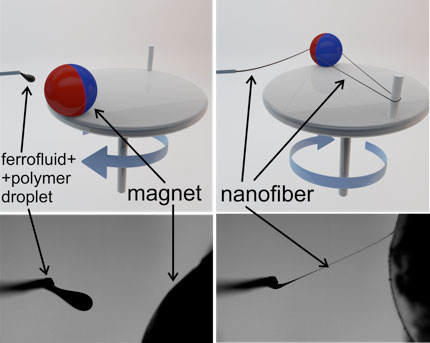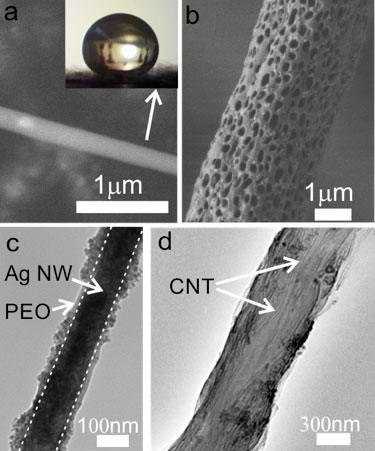| Posted: May 11, 2015 | |
How to make nanofibers using a fridge magnet (w/video) |
|
| (Nanowerk Spotlight) Nanofibers are finding a wide variety of applications for composite materials, catalysis, filtration and as a multifunctional support in biomedicine (see a collection of Nanowerk Spotlights on nanowires). | |
| The most common method for making nanofibers employs electrospinning that uses an electrical charge to draw nanofibers from a polymeric solution. This technique utilizes large voltages and is strongly influenced by the dielectric properties of the material. It is also impossible to electrospin many biopolymers without blending with another polymer; similarly, it is impossible to electrospin pure Teflon® nanofibers without using another polymer as a core. | |
| Addressing these drawbacks, a team of researchers from the University of Georgia, Princeton University and Oxford University report a new method – magnetospinning – which utilizes a simple set-up that is independent of the dielectric constant of the solvent and polymer used. | |
| The paper has been published in the May 8, 2015, online edition of Advanced Materials ("Magnetospinning of Nano- and Microfibers"). | |
| "Our method for spinning of continuous micro- and nanofibers uses a permanent revolving magnet," Alexander Tokarev, Ph.D., a Research Associate in the Nanostructured Materials Laboratory at the University of Georgia, tells Nanowerk. "This fabrication technique utilizes magnetic forces and hydrodynamic features of stretched threads to produce fine nanofibers." | |
 |
|
| Figure 1: Schematic of the magnetospinning set-up. Polymer solution is pushed through the needle while a magnet is rotating on a circular stage. Red and blue colors represent, respectively, the north and south poles of the spherical magnet. (Image: Dr. Alexander Tokarev, University of Georgia) | |
| "A ferrofluid is a colloidal dispersion of stabilized magnetic nanoparticles that responds to an external magnetic field: above a critical value for a uniform field the surface of the ferrofluid deforms and a liquid spike is formed on the surface," explains Tokarev. "In addition, as a magnet approaches an interface, the field is non-uniform, the interface always deforms, so the spike moves towards the magnet and forms a liquid bridge." | |
| In their work, the researchers explored this instability in a new method for drawing polymeric micro- and nanofibers in which the magnetic force generated by a permanent magnet is used to draw fibers with controlled diameters in the 0.05 - 5µm range. | |
| As the magnet approaches the ferrofluid (see Figure 1) the magnetic force attracts the droplet towards the magnet and a liquid bridge between the magnet and the needle is formed. The magnet moves away and draws the polymer fiber while the solvent evaporates. | |
| The resulting nanofibers are spooled on a reel that is attached to the opposite side of the stage. | |
| "The new method provides excellent control over the fiber diameter and is compatible with a range of polymeric materials and polymer composite materials including biopolymers," notes Tokarev. "Our research showcases this new technique and demonstrates its advantages to the scientific community." | |
| "For example" he continues, "polymers with low dielectric constant cannot be electrospun without adding high dielectric constant ingredients but can be easily magnetospun, for example Teflon® fluoropolymer fibers that are ideal for the design of superhydrophobic materials." | |
| Slow motion nanofiber production. | |
| Electrospinning is the most popular method to produce nanofibers in labs now. Owing to its simplicity and low costs, a magnetospinning set-up could be installed in any non-specialized laboratory for broader use of magnetospun nanofibers in different methods and technologies. | |
| The total cost of a laboratory electrospinning system is above $10,000. In contrast, no special equipment is needed for magnetospinning. It is possible to build a magnetospinning set-up, such as the University of Georgia team utilizes, by just using a $30 rotating motor and a $5 permanent magnet. | |
 |
|
| Figure 2: SEM and TEM images of fibers produced via magnetospinning. a) Magnetospun Teflon® fiber. Inset shows water droplet on the mat for Teflon® fibers b) Porous non-magnetic PMMA fibers. c) Poly(ethylene oxide) (PEO) fiber with embedded silver nanowire (Ag NW) (1.7 wt% of silver nanowires). D) TEM image of PEO fiber with embedded multi-walled carbon nanotubes (10 wt% of MWCNT). (Reprinted with permission by Wiley-VCH Verlag) | |
| The team's investigations showed that the productivity and scalability of magnetospinning is comparable with electrospinning methods. They demonstrated the universality of the new method by fabricating several examples of different polymeric fibers, including Teflon® fibers, fibers with aligned carbon nanotubes, silver nanowires, and porous fibers – all obtained with the same experimental set-up (see Figure 2). | |
 By
Michael
Berger
– Michael is author of three books by the Royal Society of Chemistry:
Nano-Society: Pushing the Boundaries of Technology,
Nanotechnology: The Future is Tiny, and
Nanoengineering: The Skills and Tools Making Technology Invisible
Copyright ©
Nanowerk LLC
By
Michael
Berger
– Michael is author of three books by the Royal Society of Chemistry:
Nano-Society: Pushing the Boundaries of Technology,
Nanotechnology: The Future is Tiny, and
Nanoengineering: The Skills and Tools Making Technology Invisible
Copyright ©
Nanowerk LLC
|
|
|
Become a Spotlight guest author! Join our large and growing group of guest contributors. Have you just published a scientific paper or have other exciting developments to share with the nanotechnology community? Here is how to publish on nanowerk.com. |
|
